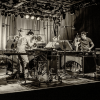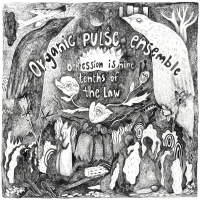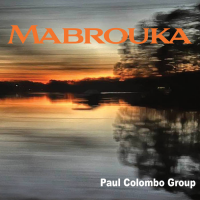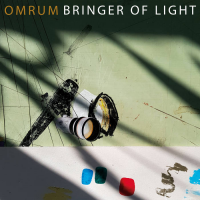Home » Jazz Articles » Album Review » Mannheimer Schlagwerk: The Numbers are Dancing
Mannheimer Schlagwerk: The Numbers are Dancing
Mannheimer Schlagwerk's artistic director Dennis Kuhn opens the album with "Leon's House (Epitaph for a friend)." In this context he is a bit of a wild card, since most listeners will be unfamiliar with him as a composer. But he has the advantage of intimate familiarity with the ensemble, and his piece is beautiful and idiomatic. It starts out slowly, as is fitting for a memorial, including a lovely bowed section, before building to a somewhat knotty conclusion. Nik Bärtsch's Ronin is known for its minimalist "zen funk." Here Bärtsch applies the same thinking to the percussion ensemble with "Seven Eleven." The title refers to the rhythmic structure of 11/4 which eventually splits off into 7/4. But, as usual, it feels completely natural, a testament to the familiarity with such odd rhythms shared by performers and composer alike.
Stephan Thelen's compositions both expand the group beyond a quartet. "Russian Dolls" adds organ and clarinet, giving a greater range of sustained tones (although the organ is also used rhythmically, which is a nod to Reich's practice). "Parallel Motion" adds two percussionists, producing a layer of activity beyond the mallet instruments. The double-time feel builds to a massive climax. Markus Reuter's "Sexgott" uses the mallet ensemble to revisit his own sound world, in which the instrumental parts combine to create a whole which is more than the sum of its parts. His approach employs less rhythmic drive than most of the other pieces on the album, but the result is a different, subtle group sound. The trio of short pieces (named for heavenly bodies) brings the program to a gentle conclusion.
Track Listing
Leon's House (Epitaph for a friend); Seven Eleven; Russian Dolls; Parallel Motion; Sexgott I: Mars; Sexgott II: Venus; Sexgott III: Eros.
Personnel
Mannheimer Schlagwerk
band / ensemble / orchestraMarcelin Huguet
vibraphoneAndreas Triefenbach
vibraphoneBrian Maier
percussionImmanuel Thomas
vibraphoneYing-Chen Chuang
percussionLukas Heckmann
percussionNawon Lee
clarinetDennis Kuhn
vibraphoneAdditional Instrumentation
Marcelin Huguet: vibraphone; Andreas Triefenbach: vibraphone, marimba [1]; Brian Maier: marimba; Immanuel Thomas: marimba, vibraphone [1]; Ying-Chen Chuang: marimba [3], percussion [4]; Lukas Heckmann: organ [3], percussion [4]; Nawon Lee: clarinet [3]; Dennis Kuhn: artistic director.
Album information
Title: The Numbers are Dancing | Year Released: 2021 | Record Label: Solaire Records
Tags
About Mannheimer Schlagwerk
Instrument: Band / ensemble / orchestra
PREVIOUS / NEXT
Support All About Jazz
 All About Jazz has been a pillar of jazz since 1995, championing it as an art form and, more importantly, supporting the musicians who make it. Our enduring commitment has made "AAJ" one of the most culturally important websites of its kind, read by hundreds of thousands of fans, musicians and industry figures every month.
All About Jazz has been a pillar of jazz since 1995, championing it as an art form and, more importantly, supporting the musicians who make it. Our enduring commitment has made "AAJ" one of the most culturally important websites of its kind, read by hundreds of thousands of fans, musicians and industry figures every month.





















